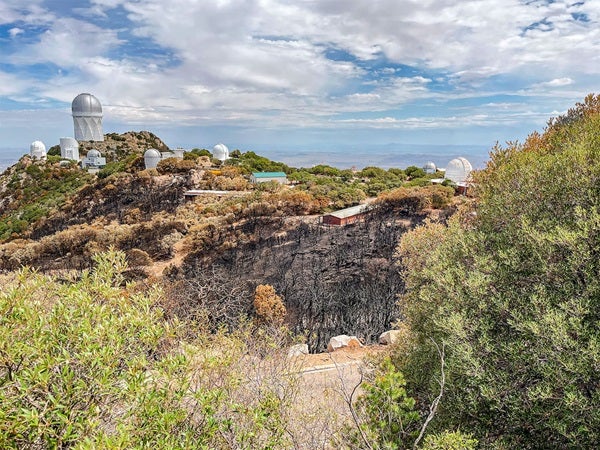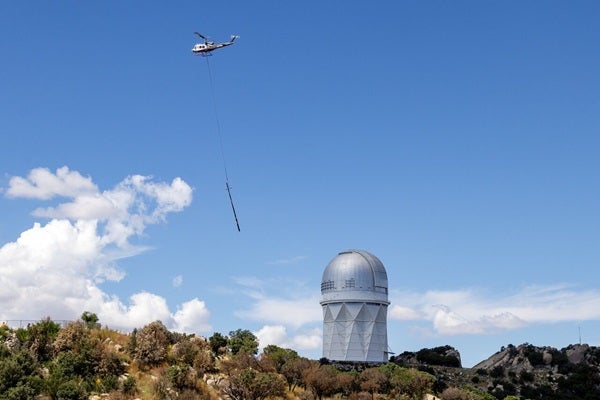The instruments at the Kitt Peak National Observatory (KPNO) in Arizona are seeing the stars once again.
On June 11, lightning struck the Baboquivari Mountain range, which includes Kitt Peak. By June 17, the so-called Contreras Fire reached the observatory-speckled mountain, burning down four support buildings. Soon after, the rains came, bringing a monsoon and causing mudslides, which damaged the roads. But the fire died down.
Since then, it has been a major undertaking to get Kitt Peak’s observatories and the surrounding area up and running again. But KPNO is on its way to recovery.
In September, with the help of generators and back-up drives, the Nicholas U. Mayall 4-meter Telescope and other instruments began collecting data once again. Power to the main summit was restored last week, but the Southwest Ridge, which received the brunt of the fire damage, will require a few more weeks to fix.
Restoring power
Michelle Edwards, Assistant Director of KPNO, tells Astronomy that the fire damaged or destroyed 18 power poles, many of which strung power lines through incredibly difficult-to-reach sections of the mountain. With no electricity until recently, Edwards and her team were forced to come up with another way to power observations of the night sky.
The solution? Generators.
“To reopen the larger-aperture telescopes safely for science, which we did at the beginning of September, our teams decided that a main source of power and a backup were needed at all times,” says Edwards. “The result was that each of the two main power grids on the main summit used a permanent generator (already on-site) and a rental generator.” And to be safe — and allow for maintenance — KPNO sometimes relied on multiple rental generators for each power grid.
This was a logistical feat all on its own, as the roads were still in bad shape and the generators required fluid monitoring and fuel refills multiple times per week. That’s why contractors and staff worked closely with Arizona Department of Transportation (ADOT) to get up the mountain. Some teams even traveled in groups to cause less of a disturbance.
The network path cannot be found
A lack of electricity wasn’t the only problem KPNO faced, either. Normally, data collected by the telescopes is transmitted over KPNO’s high-speed network. But the fire also knocked out this network, so the facility had to figure out how to store the roughly 80 gigabytes of data it collects each night.
To address this concern, for now, observational data on 150,000 celestial objects is being loaded onto external hard drives and physically driven about 55 miles (88.5 kilometers) to Tucson for processing.
Fortunately, this painstaking workaround is expected to come to an end within the next month, according to a release from the Department of Energy’s Lawrence Berkeley National Laboratory, which operates the Mayall Telescope’s Dark Energy Spectroscopic Instrument, better known as DESI. This deep-sky survey instrument is helping astronomers create a 3D map of the universe to better understand dark energy.
Scoping out the scopes
Despite the fire destroying a few of KPNO’s non-scientific buildings, the two-dozen telescopes on the mountain remain mostly unharmed by the blaze. This was no stroke of luck, either.
According to a Lawrence Berkeley Laboratory press release, Matthew Evatt, a mechanical engineering manager at NSF’s NOIRLab, and Bob Stupak, an electronics maintenance supervisor at NOIRLab, went as far as climbing up and securing plastic sheets over the Mayall telescope’s 4-meter mirror. They also covered DESI’s corrector barrel, which houses six glass lenses in precise alignment.
After the fire, when workers could access the buildings again, they began the arduous task of cleaning ash and debris from all the telescopes’ delicate lenses and small parts. “This took on the order of a month,” says Edwards, “though different telescopes proceeded at different paces, and some are still in the process of recovery and remediation.”
For example, before it was given the go ahead, DESI was quadruple checked for any depletions in functionality; the filters were changed, and it was cleaned with a carbon dioxide wash.
“It feels really great to be back on sky again,” said Claire Poppett, one of DESI’s lead observers, in the press release. “The fact that the telescope and instrument is still there is all we need — and it just needs a small tune-up to be as good as before.”
Despite the delay, the DESI team doesn’t expect the fire to have any lasting impact on their planned 2023 release of DESI data. In its first year of observations, the instrument has already exceeded expectations, capturing redshifts for 14 million galaxies and quasars (accounting for roughly 30 percent of its planned total).
Visitors still on hold
Although the scientific portion of the facility is now largely operating, visitors will have to wait a bit longer before they can return to Kitt Peak. The mudslides not only took out guard rails, they left a sedan-sized boulder on the snaking access road to the top of Kitt Peak.
“ADOT has been working to clear culverts, fix road damage, and clear rocks and boulders to allow our crew daily access, but fully opening the road to the public will take time,” says Edwards. “Still, we are working with ADOT to come up with ways to allow some public access to the summit. We are excited to welcome back visitors as soon as it is safe.”











